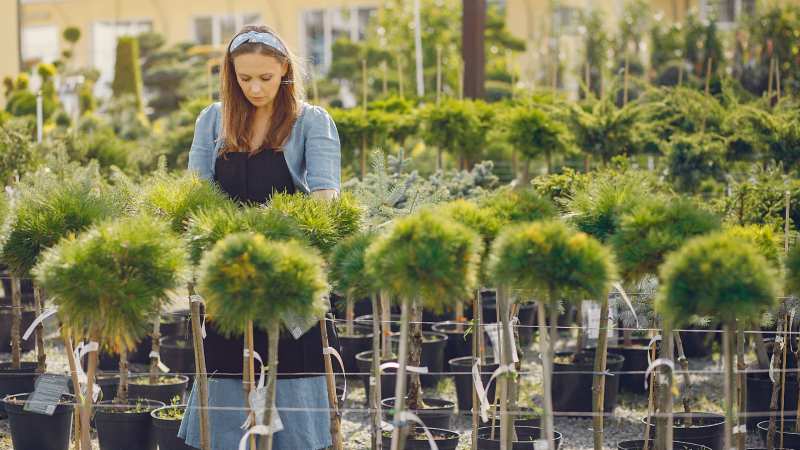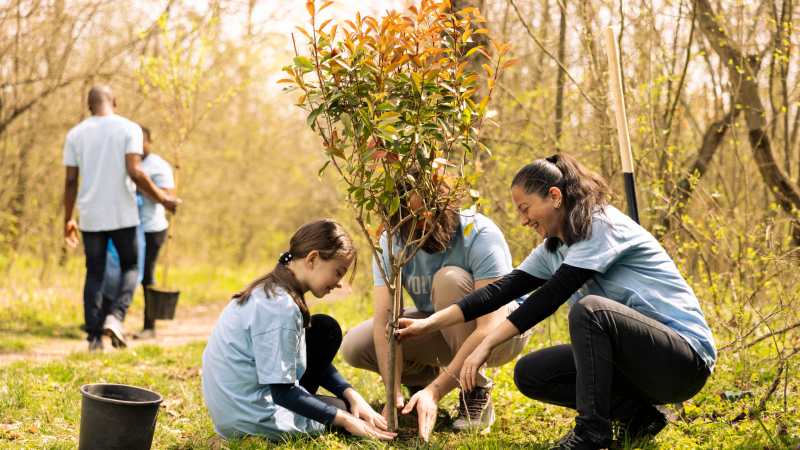Trees are among the most valuable and beautiful features you can add to your home’s environment. They provide shade, purify the air, enhance curb appeal, and create a calming, natural atmosphere that supports both your well-being and the planet. Whether you have a sprawling backyard or a compact urban garden, understanding how to select, plant, and maintain trees can transform your outdoor space into a vibrant, sustainable haven.
This comprehensive guide covers everything you need to know about choosing the right types of trees, caring for them through the seasons, and ensuring they thrive for years to come.
1. The Importance of Trees in Home Landscaping
Trees serve far more purposes than simply adding beauty to your surroundings. They play a vital role in maintaining a healthy, balanced environment.
a. Environmental Benefits:
Trees absorb carbon dioxide and release oxygen, helping to purify the air and reduce pollution. Their roots stabilize the soil, preventing erosion, while their canopies provide habitats for birds and beneficial insects.
b. Energy Efficiency:
Strategically placed trees can significantly reduce energy costs. Shade from large trees keeps homes cooler in the summer, while evergreens can act as windbreaks during winter.
c. Property Value and Aesthetics:
Homes surrounded by healthy, mature trees tend to have higher property values. Beyond financial benefits, the beauty of well-chosen trees enhances the overall appeal of any home.
d. Mental and Physical Health:
Being around greenery has proven psychological benefits. Trees create peaceful environments that encourage outdoor relaxation, exercise, and stress reduction.
In short, trees are a long-term investment in both your property and quality of life.
2. Choosing the Right Trees for Your Home

Not all trees are suited for every space or climate. The right choice depends on factors like soil quality, available space, and maintenance needs.
a. Consider Your Climate:
Choose tree species that thrive in your region’s temperature range and rainfall. Local nurseries can recommend native trees that naturally adapt to your soil and weather conditions.
b. Space and Growth Patterns:
Before planting, consider the tree’s mature height and spread. Large trees should be placed at least 15–20 feet from buildings or power lines to prevent future issues.
c. Purpose and Function:
-
Shade Trees: Maple, oak, and ash provide cooling shade and shelter.
-
Ornamental Trees: Dogwood, cherry blossom, and magnolia add beauty and color.
-
Fruit Trees: Apple, lemon, or pear trees offer beauty and a sustainable food source.
-
Evergreens: Pine, cedar, or spruce offer year-round privacy and greenery.
Selecting the right tree ensures healthy growth, easy maintenance, and long-term harmony with your home’s landscape.
3. Preparing the Soil and Planting Trees Correctly
Proper planting is crucial for a tree’s success. Poor soil preparation or incorrect planting depth can stunt growth or cause disease.
a. Soil Preparation:
Test your soil’s pH and nutrient levels. Most trees prefer well-draining soil with balanced moisture. Enrich the ground with compost or organic matter to boost fertility.
b. Digging the Hole:
Create a hole that’s two to three times wider than the root ball but not deeper than the roots themselves. Planting too deep can suffocate roots, while shallow planting may lead to instability.
c. Planting Steps:
-
Place the tree in the hole with its roots naturally spread.
-
Backfill the hole gently with loose soil.
-
Water thoroughly to remove air pockets.
-
Add mulch around the base to retain moisture and regulate soil temperature.
d. Staking Young Trees:
If your area is windy, use stakes to support young trees during their first year. However, remove them once roots are established to allow natural movement and strengthening.
4. Watering and Feeding Your Trees
Watering and nourishment are key to helping your trees flourish. The needs vary by species and season, but a few general guidelines apply to most home landscapes.
a. Watering Frequency:
-
Newly planted trees need deep watering once or twice a week.
-
Mature trees generally thrive with occasional deep watering, depending on rainfall.
-
Avoid shallow watering, as it encourages surface roots and weak growth.
b. Fertilizing Tips:
Use slow-release, organic fertilizers during spring or early summer. Avoid over-fertilization, which can cause excessive growth and weaken the tree’s structure.
c. Mulching Benefits:
A 2–3 inch layer of mulch helps retain soil moisture, prevent weeds, and regulate temperature. Keep mulch a few inches away from the trunk to avoid rot.
5. Pruning and Maintenance for Healthy Growth
Pruning not only shapes trees but also promotes strong, disease-free growth.
a. When to Prune:
-
Deciduous trees: Late winter or early spring before new growth begins.
-
Flowering trees: After their blooming season.
-
Evergreens: Light pruning throughout the year.
b. How to Prune Properly:
-
Remove dead, diseased, or crossing branches.
-
Trim suckers and low-hanging branches.
-
Always use sharp, clean tools to prevent damage.
c. Regular Inspection:
Check for pests, cracks, or signs of decay. Early detection helps prevent larger issues later.
Proper maintenance ensures your trees remain strong, attractive, and safe for years to come.
6. Common Tree Problems and How to Solve Them
Even healthy trees face challenges from pests, weather, and disease. Here are some common issues and their solutions:
-
Yellowing Leaves: May indicate nutrient deficiency or overwatering. Check soil drainage.
-
Cracked Bark: Usually caused by frost or rapid temperature changes. Protect trunks during winter.
-
Fungal Growth: Prune infected branches and improve air circulation.
-
Pests: Aphids, borers, and caterpillars can harm leaves and bark. Use natural repellents or horticultural oils.
Regular observation and timely care prevent these problems from spreading.
7. Seasonal Tree Care Tips
Each season brings new challenges and opportunities for maintaining your trees.
Spring:
-
Check for winter damage and prune broken branches.
-
Apply compost or fertilizer for fresh growth.
-
Water deeply as temperatures rise.
Summer:
-
Maintain a regular watering schedule.
-
Protect trees from drought stress with mulch.
-
Watch for pests and remove dead limbs.
Autumn:
-
Clean fallen leaves and debris.
-
Prepare trees for winter by pruning lightly and watering before the ground freezes.
-
Add a fresh layer of mulch for insulation.
Winter:
-
Shield young trees from frost with burlap wraps.
-
Avoid heavy pruning during extreme cold.
-
Inspect after snowstorms for broken branches.
Seasonal care ensures your trees remain resilient year-round.
8. The Role of Trees in Sustainable Living

In modern home design, sustainability is a key priority — and trees play a central role.
-
Carbon Reduction: Trees absorb carbon dioxide, helping offset household emissions.
-
Water Conservation: Tree roots improve soil water retention.
-
Wildlife Support: They create natural ecosystems for birds, pollinators, and small animals.
-
Cooling Effect: A shaded yard can reduce air-conditioning needs, lowering energy use.
Planting and caring for trees is one of the simplest yet most impactful ways homeowners can contribute to environmental health.
9. Safety and Legal Considerations
Before planting or removing trees, be aware of local regulations and property lines.
-
Check for Underground Utilities: Contact local authorities to identify cables or pipelines before digging.
-
Know Property Boundaries: Avoid planting too close to neighboring properties.
-
Comply with Tree Protection Laws: Some cities restrict cutting or trimming certain tree species.
Taking these precautions prevents future disputes and ensures responsible landscaping practices.
10. Designing a Landscape with Trees
Integrating trees into your landscape design creates a balanced and inviting outdoor space.
-
Combine large shade trees with smaller ornamental varieties for visual depth.
-
Pair trees with shrubs, flowers, and pathways for layered beauty.
-
Use lighting to highlight trees at night for ambiance.
-
Leave open areas for airflow and movement.
When thoughtfully planned, your trees become the heart of your outdoor aesthetic.
Conclusion
Incorporating trees into your home environment provides countless benefits — from improving air quality to adding natural beauty and tranquility. With proper care, thoughtful placement, and regular maintenance, your trees can grow strong and healthy for generations to enjoy.
Whether you’re planting your first sapling or maintaining a mature backyard, remember that trees are living investments that contribute to a sustainable, peaceful, and vibrant home.
FAQs About Trees
1. How often should I water newly planted trees?
Water them deeply once or twice a week during the first year to help roots establish. Adjust based on rainfall.
2. What’s the best time to plant trees?
Early spring or fall is ideal since moderate temperatures encourage strong root development.
3. How can I protect trees from pests naturally?
Use neem oil, insecticidal soap, or introduce beneficial insects like ladybugs to keep harmful pests under control.
4. How do I know if a tree is unhealthy?
Look for signs such as wilting leaves, bark cracks, or fungus at the base. Address issues promptly with pruning or soil care.
5. Can trees increase my home’s value?
Yes. Mature, well-maintained trees enhance curb appeal and can raise property values by 10–20%.
6. Should I prune trees myself or hire a professional?
Minor pruning is fine for homeowners, but large or high branches should be handled by a certified arborist for safety.
7. How far should I plant a tree from my house?
Typically, plant large trees 15–20 feet away and smaller trees 8–10 feet away to prevent root interference.

